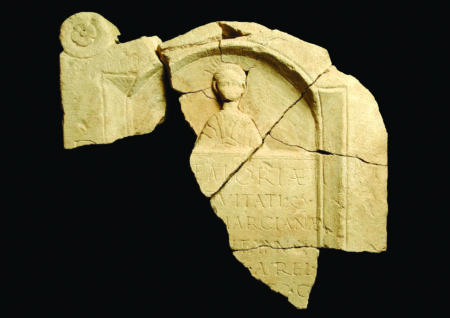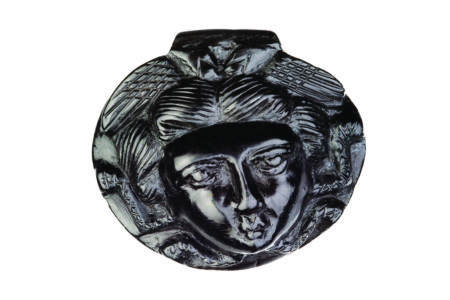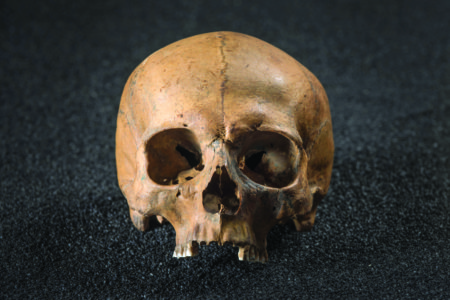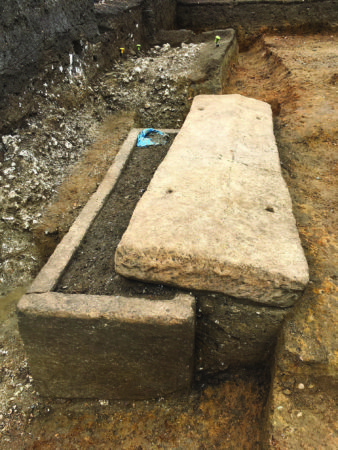Interview – Roman Dead with Meriel Jeater
Armed with a BA in archaeology and ancient history and an MA in museology, Meriel Jeater joined the Museum of London in 2000 and has worked on a wealth of archaeological collections for the museum ever since. Her previous works include the permanent Medieval London gallery, the War, Plague and Fire gallery, and most recently she curated Fire Fire!, which explores the 1666 Great Fire of London. In a new exhibition titled Roman Dead (opening 25 May at Museum of London Docklands) Meriel and a team of curators will reveal the remarkable discovery of a Roman cemetery excavated from Harper Road in Southwark last year.
What first drew you to a career in archaeology?
When I was a child my father took us to see ancient ruins in Greece, which got me hooked on studying the past. A group of archaeologists visited my class at primary school and taught us how to dig mini excavations that they’d made especially for us using layers of soil in fish tanks. I loved it and decided to become an archaeologist! However, having actually been on a proper excavation when I was studying archaeology at university, I discovered I liked the objects and the history but not the mud and hard work, so I became a museum curator instead.
How did you feel when you first heard that a rare sarcophagus had been discovered on a building site, now a Roman cemetery, last year?
It was very exciting to learn about the discoveries at Harper Road. Roman sarcophagi are rare finds in London, plus there was the intriguing mystery about who might have been buried inside. The sarcophagus was moved – still with all the soil inside – to our store in Hackney so that archaeologists from Pre-Construct Archaeology (PCA) could excavate it carefully in a controlled environment. They are still analysing the contents and we look forward to finding out more shortly.
How do you approach curating an exhibition such as Roman Dead?
This is very much a collaborative effort – I’m working with my colleagues Jackie Keily, who is senior curator for the prehistoric and Roman collections, and Dr Rebecca Redfern, who is a bioarchaeologist specialising in the study of ancient human remains. We also have help from many other colleagues both at the Museum of London and from external organisations such as PCA, who found the sarcophagus, and Museum of London Archaeology (MOLA). We really wanted to set our display of the sarcophagus in the context of Roman burials in London so that visitors could understand more about its significance and how it compares to other burials of the period. We also aim for visitors to be able to make connections with people who lived in London nearly 2,000 years ago by exploring some of the rituals and beliefs
around burial.
What can the discovery of this cemetery add to the world’s knowledge about Romans and their history?
Every time an archaeological excavation uncovers Roman remains in London we learn more about this period of British history, for which very few written records survive. Usually excavations can only take place before construction projects, so only pockets of London have been investigated in this way. Each excavation helps to create a bigger picture of what Roman London was like. The Harper Road excavations have found more of the cemetery that lay to the south of Londinium [the Roman name for London] and part of a Roman road, which helps us to understand how London was connected to the rest of the province.

The tombstone of ten-year-old Marciana, found during excavations of the city wall, will also be on display
In your opinion, what is the most interesting object on display at the exhibition?
It’s hard to choose, as there are so many fascinating things. One of my personal highlights is the tombstone of a ten-year-old girl called Marciana. The inscription on the tombstone says it was set up by her father Aurelius in her ‘everlasting memory’. The use of this phrase is usually found on tombstones from the Rhine and Danube regions of the Roman Empire, so it’s likely that Marciana and her father came to London from abroad. The tombstone includes a portrait of a young girl who is meant to symbolise Marciana herself. It was found during excavations of the Roman city wall; [it had been] re-used as building rubble in a 4th-century tower. I find it amazing that a broken-up tombstone in a tower has been able to give us the name of a young girl who lived in Roman London.

During excavations at Hooper Street, a jet Medusa pendant was found buried with the skeleton of a woman
One of the artefacts displayed is the jet pendant of Medusa. What can this tell us about the beliefs of those buried?
Jet has electrostatic properties and is thought to have had magical associations for the
Romans. Jet objects were used in daily life, but jet is frequently used as a material for burial goods, particularly jewellery and dress accessories. It may have been used to protect the dead, perhaps on their journey to the Underworld. The mythical figure of Medusa, with her snake hair and ability to turn onlookers to stone, was especially protective.
In the exhibition there are a series of human skulls with examples of blunt trauma. What can this tell us about the lives of the Romans found?
We will be showing a small number of skulls from a group of 40 that were found in waterlogged pits near London Wall. Most of the skulls were from men aged between 18 and 35 years old, and many showed signs of multiple blunt- and sharp-force traumas, showing that the men had been killed by being beaten and attacked with various weapons. Many also had healed injuries, which suggests that violence was a common feature of their lives. Why their skulls had been left in pits is uncertain. They could be the remains of executed criminals or gladiators or men who were killed for some other reason. It’s one of the many mysteries from Roman London.

Four male skulls will be on display; many similar skulls that have been excavated show signs of multiple blunt- and sharp-force trauma
Are there any particular similarities between a Roman burial and a modern-day burial?
There were many different burial styles in Roman London. Particularly in the early Roman period, a lot of people were cremated and their burnt bones put into containers and buried. Today, many people have their ashes scattered – we don’t know if this happened in the Roman period, as their remains would normally not survive. As time went on inhumation (the burial of a corpse) became more common. However, there were a wide variety of burial methods used, such as wood or lead coffins (and occasionally stone, as seen at Harper Road), or no coffin at all. The majority of people were buried on their backs, but some were found on their sides or even face down.
Roman Dead opens at the Museum of London Docklands on 25 May and runs until 28 October 2018. For more information, visit: www.museumoflondon.org.uk/romandead
Images © Museum of London; Southwark Council







